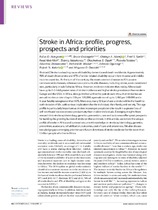| dc.contributor.author | Akinyemi, R.O. | |
| dc.contributor.author | Ovbiagele, B. | |
| dc.contributor.author | Adeniji, O.A. | |
| dc.contributor.author | Sarfo, F.S. | |
| dc.contributor.author | Ogah O.S.a, k,Naidoo P.l,Damasceno A.m,Walker R.W.a, n, o,Ogunniyi A.a, c,Kalaria R.N.a, d | |
| dc.contributor.author | Adoukonou, T. | |
| dc.contributor.author | Ogah, O.S. | |
| dc.contributor.author | Naidoo, P. | |
| dc.contributor.author | Damasceno, A. | |
| dc.contributor.author | Walker, R.W. | |
| dc.contributor.author | Ogunniyi, A. | |
| dc.contributor.author | Kalaria, R.N. | |
| dc.contributor.author | Abd-Allah, Foad | |
| dc.date.accessioned | 2021-10-04T08:11:53Z | |
| dc.date.available | 2021-10-04T08:11:53Z | |
| dc.date.issued | 2021 | |
| dc.identifier.citation | Akinyemi, Rufus & Ovbiagele, Bruce & Adeniji, Olaleye & Sarfo, Fred & Abd-Allah, Foad & Adoukonou, Thierry & Ogah, Okechukwu & Naidoo, Pamela & Damasceno, Albertino & Walker, Richard & Ogunniyi, Adesola & Kalaria, Rajesh & Owolabi, Mayowa. (2021). Stroke in Africa: profile, progress, prospects and priorities. Nature Reviews Neurology. 17. 1-23. 10.1038/s41582-021-00542-4. | en_US |
| dc.identifier.issn | 17594758 | |
| dc.identifier.uri | 10.1038/s41582-021-00542-4 | |
| dc.identifier.uri | http://hdl.handle.net/10566/6861 | |
| dc.description | Funding text 1
R.O.A. is supported by the UK Royal Society/African Academy of Sciences FLAIR Grants FLR/R1/191813 and FCG/R1/ 201034, and a GCRF Networking Grant from the UK Academy of Medical Sciences. R.O.A., M.O.O., B.O. and F.S.S. are also supported by grants U54HG007479 and U01HG010273 from the US National Institutes of Health (NIH) as part of the H3Africa Consortium. M.O.O., B.O., R.O.A. and F.S.S. are further supported by NIH grant R01NS107900. R.N.K.’s research on elderly survivors of stroke has been supported by the Medical Research Council, RCUK Newcastle Centre for Brain Ageing and Vitality (MRC G0500247), Alzheimer’s Research UK, the Dunhill Medical Trust, UK, and the Newcastle National Institute for Health Research Biomedical Research Centre in Ageing and Age-Related Diseases, Newcastle upon Tyne Hospitals National Health Service Foundation Trust.
Funding text 2
funds provided by the Wellcome Trust and the NIH. The NIH-funded SIREN study is exploring the genetic architecture of stroke among Indigenous Africans. More than 4,000 case–control pairs have already been recruited to the study and several publications on stroke phenom-ics and preliminary candidate gene analyses have been generated. The SIREN study has also undertaken the first-ever GWAS to unravel the genetic architecture of stroke in Indigenous Africans and the results are eagerly awaited. Stroke neurobanking resources consisting of blood fractions, extracted DNA, neuroimages and databases of clinical information are also being built in Africa and could facilitate data science-driven trans-omics research (including epigenomics, tran-scriptomics, proteomics and metabolomics) as well as the development of precision medicine products such as Afrocentric risk calculators, polygenic risk scores, biomarkers and drug targets23–25,227,307,308. The SIREN neurobiobank comprises a group of constantly monitored ultra-low-temperature (–86 °C) freezers located in Ibadan, Nigeria, constantly powered –20 °C chest freezers located in Ibadan and other recruitment sites, barcode scanners and printers, a laboratory information management system, a secure multi-terabyte server, | en_US |
| dc.description.abstract | Stroke is a leading cause of disability, dementia, and death worldwide. Approximately 70% of deaths from stroke and 87% of stroke-related disabilities occur in low-income and middle-income countries. At the turn of the century, the most common diseases in Africa were communicable diseases, whereas non-communicable diseases, including stroke, were considered rare, particularly in sub-Saharan Africa. However, evidence indicates that today, Africa could have up to 2–3-fold greater rates of stroke incidence and higher stroke prevalence than western Europe and the USA. In Africa, data published within the past decade show that stroke has an annual incidence rate of up to 316 per 100,000, a prevalence of up to 1,460 per 100,000, and a 3-year fatality rate greater than 80%. Moreover, many Africans have a stroke within the fourth to sixth decades of life, with serious implications for the individual, their family, and society. This age profile is particularly important as strokes in younger people tend to result in a greater loss of self-worth and socioeconomic productivity than in older individuals. Emerging insights from research into stroke epidemiology, genetics, prevention, care, and outcomes offer great prospects for tackling the growing burden of stroke on the continent. In this article, we review the unique profile of stroke in Africa and summarize current knowledge on stroke epidemiology, genetics, prevention, acute care, rehabilitation, outcomes, cost of care, and awareness. We also discuss knowledge gaps, emerging priorities, and future directions of stroke medicine for the more than 1 billion people who live in Africa. © 2021, Springer Nature Limited. | en_US |
| dc.description.sponsorship | Newcastle National Institute for Health Research Biomedical Research Centre in Ageing and Age-Related Diseases
Newcastle upon Tyne Hospitals National Health Service Foundation Trust
RCUK Newcastle Centre for Brain Ageing and Vitality
Royal Society/African Academy of Sciences: FCG/R1/ 201034,FLR/R1/191813
National Institutes of Health (NIH): R01NS107900
Wellcome Trust (WT)
Medical Research Council (MRC): G0500247
Dunhill Medical Trust (DMT)
Academy of Medical Sciences: U01HG010273,U54HG007479
Alzheimer’s Research UK (ARUK) | en_US |
| dc.language.iso | en | en_US |
| dc.publisher | Spring Nature Limited | en_US |
| dc.subject | Stroke | en_US |
| dc.subject | Disability | en_US |
| dc.subject | Dementia | en_US |
| dc.subject | Low-income | en_US |
| dc.subject | Middle-income | en_US |
| dc.subject | Africa | en_US |
| dc.subject | Non-communicable diseases | en_US |
| dc.subject | sub-Saharan Africa | en_US |
| dc.subject | Stroke epidemiology | en_US |
| dc.subject | Genetics | en_US |
| dc.subject | Prevention | en_US |
| dc.subject | Acute care | en_US |
| dc.subject | Rehabilitation | en_US |
| dc.subject | Outcomes | en_US |
| dc.subject | Awareness | en_US |
| dc.title | Stroke in Africa: Profile, progress, prospects and priorities | en_US |
| dc.type | Article | en_US |

